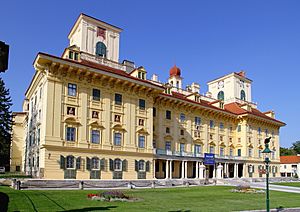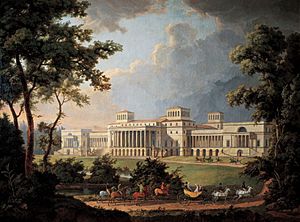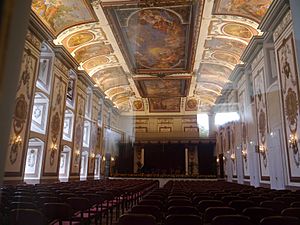Schloss Esterházy facts for kids
Schloss Esterházy (which means Esterházy Palace) is a beautiful palace in Eisenstadt, Austria. Eisenstadt is the capital city of the Burgenland region. The palace was first built in the late 1200s. In 1622, it became the property of the powerful Esterházy family from Hungary.
Under Prince Paul I Esterházy, the building was changed into a grand baroque castle. For more than 300 years, it was the main home and office for the Esterházy family. The famous composer Joseph Haydn worked here for most of his life.
Contents
History of Schloss Esterházy
The palace has a long history of changes. It started as a medieval castle built for defense. Over time, it became a fancy palace designed for comfort and showing off wealth. The moats (water ditches for defense) were removed in the early 1800s. The palace's style was updated many times to match the popular tastes of different eras.
Early Days of the Palace
- 1364: The palace became the property of the strong Kanizsai family. They made many improvements to it.
- 1371: King Louis I bought the castle. He turned it into a "medieval city castle" that was part of the city of Kismarton's defenses.
- 1622: The Esterházy family took ownership of the palace.
Baroque Style Changes (1663–1672)
After Count Ladislaus Esterházy died in a battle in 1652, his younger brother Paul inherited the palace. The changes he made took almost ten years to finish. These changes gave the palace the look we see today. An Italian artist named Andrea Bertinalli created the rich stucco decorations.
1700s Palace Updates
Not many big changes happened during the high and late baroque periods. In the 1700s, mostly the inside design and staircases were updated. Most rooms got new furnaces and stucco ceilings. The only major building work was replacing the two main staircases. These staircases are still the same today.
The palace was one of the summer homes for the Esterházy family when Joseph Haydn worked for them.
Classical Style Changes
Prince Anton Esterházy made many changes, even though he was in charge for only a short time (1790–1794).
His son, Prince Nikolaus II, loved to spend money. He started a project to change the palace into the Classical style. Nikolaus hired Charles Moreau, a famous French architect. Moreau wanted to keep only the middle part of the building in its baroque style. He planned to add many new parts in the classical style.
The eastern side was meant for a theater and opera house. The western side would hold the Esterházy art gallery. Between the two north towers, a garden hall would become the amazing Haydnsaal we see today. Moreau also designed a grand entrance for this hall. It had large ramps and twenty Corinthian columns. He also created many different "high society" rooms, each with its own style.
However, Prince Nikolaus's money, even though he had a lot, was not enough to finish these big plans. He spent a lot on his lifestyle, art, and supporting Austria in the Napoleonic Wars. Also, the war caused high inflation and economic problems in Austria. Because of this, the renovations were never fully completed, even by later generations of princes. The grand entrance Nikolaus and Moreau planned was never finished. The main entrance to the palace is still in its original spot, facing the town.
Later History of the Palace
Renovation work finally began in the late 1800s. Few changes were made in the early 1900s. In 1945, at the end of World War II, the palace's purpose changed a lot. It housed the offices of the Burgenland state government. Later, it was used as the national court for ten years. In 1969, the Burgenland state government leased large parts of the building.
Schloss Esterházy Today
Today, the palace is owned by the Esterházy Foundation. This foundation was created by Melinda Esterházy (1920–2014). Schloss Esterházy is one of the most important palaces in Austria. It is a very popular place for tourists to visit.
Visitors can explore many rooms, see the furniture, and admire the artwork. They can also walk around the large gardens behind the palace. There is a wine museum and a gift shop. Guided tours are available, and concerts are often held in the famous Haydnsaal.
The Haydnsaal
The Haydnsaal (Haydn Hall) was originally a large room used for festivals and banquets. It is a work of art itself within Schloss Esterházy. Its size and beautiful decorations show how powerful and important the Esterházy family was.
Today, it is known as one of the most beautiful concert halls in the world. It also has excellent acoustics, meaning sound travels very well. The hall is named after the famous composer Joseph Haydn. He worked for the Esterházy family for almost forty years. Many of his musical works were composed and first performed in Kismarton and at Schloss Esterházy.
The Haydnsaal was built under Paul Esterházy I during the baroque building phase (1663–1672). It was part of plans made by Carlo Martino Carlone from Italy. These plans covered most of the northern wing of the palace. The hall stretches over three floors. On the side facing the courtyard, three windows are stacked one above the other.
In 1803, during the classical style changes, the Garden Room was added along the north side in front of the Haydnsaal. The windows that were there before were bricked up. Friedrich Rhode, the court painter, decorated the empty spaces with Biedermeier-style designs. Openings were made in the walls at both the east and west ends. These were covered by two large alcoves and were meant to be entrances to the planned opera/theater wing and gallery.
Later, two galleries were built. They were supported by four wooden columns with palm-shaped tops. Two girandoles (fancy candle holders) decorate the east wall of the grand hall.
The unique frescoes (wall paintings) in the hall are from the 1600s. They are thought to be by the painter Carpoforo Tencalla. The amazing murals and ceiling paintings show scenes from "Metamorphoses" by the Roman poet and philosopher Apuleius. The three middle sections and six rectangular panels show scenes from the story "Cupid and Psyche". The center panels show the marriage of Cupid and Psyche with the Olympic Gods watching. Scenes from their lives are shown in the rectangular panels.
The cross-shaped panels show scenes from the myth of the "Golden Apples of Hesperides". Between the ceiling frescoes, you can see the family crests of the Esterházys. Medallions on the walls, painted by Friedrich Rohde in 1793, show busts (head and shoulders statues) of Hungarian kings. These range from Stephen I to Emperor Leopold I. The 18 sandstone busts on the main outside of the palace are part of the same series.
Gallery
See also
 In Spanish: Palacio Esterházy (Eisenstadt) para niños
In Spanish: Palacio Esterházy (Eisenstadt) para niños
- List of Baroque residences

















